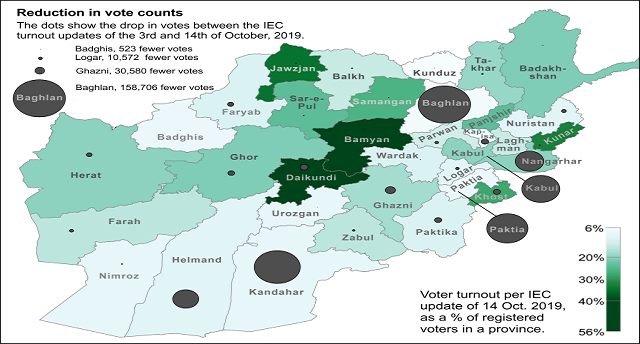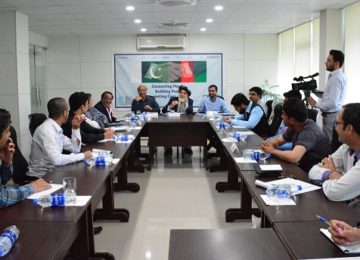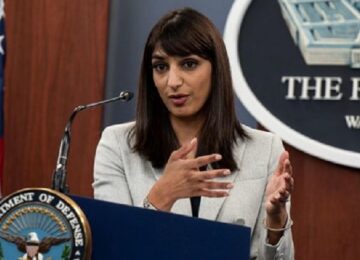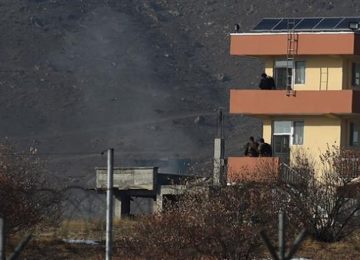November 08, 2019
Almost 40 days after the election, the Independent Election Commission (IEC) has still not been able to give a final turnout figure for the presidential election. The latest figure announced by the IEC is just over 1.8 million, but this does not seem to be the final count. As for the 770,000 to 900,000 votes which went ‘missing’ from earlier turnout figures, there is still no explanation as to whether these votes were found to be fraudulent or simply irregular. The IEC has now set 14 November for the announcement of preliminary results, after missing its planned deadline of 19 October. AAN’s Ali Yawar Adili and Jelena Bjelica have been trying to get to the bottom of these contradictory figures.
This dispatch is an attempt to find clarity from the plethora of turnout figures announced by the IEC since polling day, which have varied from a high of 2,695,890, given on 3 October, to 1,791,703, announced by commissioner Mawlana Muhammad Abdullah on 27 October. The latest figure, 1,843,107, was announced on 2 November. The nature of these turnout figures are not all the same. They vary as to whether they are: ‘biometrically-verified-voter’ (BVVed) votes; ‘valid’ BVVed votes, votes which have been ‘whitelisted’ by Dermalog, the German company that provided the biometric technology; and various other criteria. The IEC has maintained its opaque attitude to information, including why discrepancies have arisen and what the numbers actually mean, and with the teams of both front runners making claims on the vote, trying to get facts straight is a labyrinthine task. Nevertheless, we have tried to do this as far as possible, starting with the latest figure and the discrepancies between the various turnout figures of BVVed votes.
The latest BVV turnout figure
On 2 November, the IEC announced that 1,843,107 valid votes had been cast in the 28 September presidential elections. Speaking at a press conference, IEC commissioner Awrangzeb (see the video here) said Dermalog had sent the information about valid and invalid biometric votes to the IEC the day before, 1 November, and that out of a total of 1,929,333 biometric votes, 1,843,107 had been found to have valid data and “the rest have been identified as breaching the criteria.” This means that 86,226 votes were dismissed because they did not fulfil all of the criteria and had one or more of the following problems: duplicate QR codes, fingerprint discrepancies, and problems with voter registration stickers, photographs or ‘timelogs’, ie the votes had been cast before polling stations officially opened, at 7 am, or after they closed, at 5 pm (see also media report here). Awrangzeb said the IEC’s technical staff members were now working on breaking down these latest figures by province, district, polling centre and station. (1)
These Dermalog numbers were confirmed when the letter sent by Dermalog to the IEC on 1 November was circulated on social media (see for example here). As Awrangzeb had said, they placed 1,843,107 votes on what they are calling the ‘white list’. (AAN has copies of seven of Dermalog’s letters to the IEC. They are annexed to this piece in chronological order). The 1 November letter said (English as per the original):
We found out that 5,141 Votes were uploaded twice; therefore, we have corrected the white list accordingly. The total number of clean votes is 1,843,107 in the White list.
A closer look at BVV turnout updates
With the latest figure, there are now different numbers in circulation for total BVVed votes before and after ‘de-duplication’, that is, after removing votes showing irregularities, such as underage and duplicate votes. These figures are captured in the table below, and explained in the text.
| Date | Source | BVVed votes before deduplication | BBVed votes after de-duplication, aka votes on the ‘whitelist’ |
| 23 October | IEC commissioner Zarifi | 1,932,673 | |
| 23 October | Dermalog | 1,929,333 | |
| 27 October | IEC commissioner Abdullah | 1,791,703 to 1,929,333 | |
| 1 November | Dermalog | 1,843,107 | |
| 2 November | IEC commissioner Awrangzeb | 1,929,333 | 1,843,107 |
The first figure was released on 23 October by IEC commissioner Rahima Zarifi who said that a “final” count of the “biometric data” showed 1,932,673 votes (see AAN’s reporting here). She acknowledged at the time that the figure still needed to be “cleansed” by Dermalog to remove votes with irregularities (duplicate and underage votes and votes without proper document or photo verification). Even before that happened it was corrected by Dermalog to the slightly lower figure of 1,929,333. (An IEC official told AAN on 3 November that Zarifi had rushed to announce the figure as soon as it had been emailed from Dermalog, and was critical of the decision to release ‘raw data’ to the public before it had been analysed and finalised).
Following this, another IEC commissioner, Mawlana Muhammad Abdullah, said on October 26 that there were between 1,791,703 and 1,929,333 “biometrically processed votes” in the system. He used his Facebook page to share these two numbers, acknowledging a difference of 137,630 votes which he said were “subject to discussion and review.” Commissioner Abdullah repeated these two sets of figures at the IEC’s official press conference the next day. (2)
A little more clarity about these 137,630 votes emerged from Dermalog, which seems to have quarantined these votes in the system. In the first of seven letters (all can be seen in the Annex) sent on 27 October to the IEC by Dermalog project manager Merten Kobler, said (English as original): “When summing up the number of reported voters processed (recorded biometrics in that station) you end up with the 1.7 million voters.” The letter went on to provide a reason for the quarantine: in several cases, BVV operators had transmitted a result too early in the morning, which had caused the closure of that “specific device/SD-card [secure digital card or memory card]” in a polling station. The problem with these cases, the letter said, was that the BVV operators then took a backup device and continued working at the same polling station for the rest of the election day and then “transmitted a second result sheet and biometric records.” Dermalog’s letter said the company was not allowed to “correct or update these small mistakes on the server” in accordance with an “agreement with political parties and IEC in August” and thus, “the second result sheet is quarantined” by the server. (3) “The biometric [data] though are shown as they are still unique and valid,” the letter went on. “This means we have cases with a first results sheet showing for example 0 biometric records but there are actually in some cases more than 100 valid biometric on server.”
The IEC’s procedure for polling and vote count stipulates that when a new device is used in a polling station, the chairperson should insert the memory card of the previous device in the new one in order to be able to avoid repeat voting. The procedure requires that the polling station chairperson should record this in the station’s journal and ask the monitors and observers to confirm the veracity of the incident by signing the journal (see AAN’s reporting here).
Issues with the figures
Dermalog’s 1 November letter gives the “total number of clean votes” as 1,843,107 (the same number given by commissioner Awrangzeb on 2 November), but does not make any mention of the quarantined 137,630 votes. The company seems to have invalidated these votes. Nevertheless, an IEC official told AAN there has yet to be a final decision on this and the final turnout figure, but that it would be taken soon. An official from Chief Executive Abdullah Abdullah’s campaign, Nur Rahman Akhlaqi, insisted in a press conference on 4 November that those 137,630 votes which had initially been quarantined, should, indeed, be excluded. He also said a further 100,000 votes should be invalidated because they were cast outside polling hours, and that 50-70,000 votes had been cast with invalid photographs. He said that, unless and until these votes were invalidated, any recounts should not take place. However, a member of President Ashraf Ghani’s campaign, Jamal Naser Osoli told Etilaat Roz that the 137,630 votes had been found to be clean by Dermalog. He accused Abdullah’s campaign of trying to reduce the number of accepted votes in an attempt to push the election into a second round.
Dermalog sent a further letter, on 4 November, confirming that 1,843,107 represented what it called the “WHITELISTED VOTERS, who have only voted once.” It said that 137,630 “is the difference between the MANUALLY entered data and the REAL uploaded data” and that “The Manual data entry was done by the OPERATORS at the polling stations. This does NOT reflect the real number of biometric votes!” These terms – ‘manually entered’ versus ‘real uploaded data’ – are not particularly helpful, as their exact meaning was not made clear. However, the whitelist number is clear.
The company did also provide a detailed breakdown of how the data had been processed, which AAN has compiled into the following table (see Annex for the 4 November Dermalog letter which contains the figures).
| Total biometric datasets registered and uploaded | 1,929,333 |
| Reasons for Removal | Number of votes |
| Duplicate faces | 47,527 |
| Duplicate fingerprints | 5,822 |
| Duplicate voter numbers | 37,006 |
| Double uploaded | 5,141 |
| Total duplicates found | 95,596 |
| Duplicates matching one or multiple criteria | 9,270 (so deducted from the total duplicates) |
| Duplicate voters found | 86,226 |
| Total whitelisted voters who only voted once | 1,843,107 |
Table by AAN with figures from Dermalog’s 4 November letter (NB: The “Total duplicates found” figure appears to be a typo. It should be 100 fewer, ie 95,496.)
This letter should bring some clarity, but it seems that at least some of IEC commissioners are not happy yet with the company’s explanation. For instance, IEC commissioner Abdullah wrote on his Facebook page a day after Dermalog’s letter, on 5 November, that there was still insufficient clarity about the 137,630 quarantined votes; he said their “address” needed clarifying, probably meaning ‘source’, or ‘provenance’; he also raised the fate of 102,012 votes cast outside polling time, before 7 am or after 5 pm (which Chief Executive Abdullah’s team has also raised). Commissioner Abdullah also said there was a need to: specify which [polling] stations are to see a recount to separate ‘clean’ and ‘invalid’ votes; plan for recounts at the centres and provinces and; get approval of those plans by the IEC. Commissioner Abdullah suggested that until these issues were resolved, any recount would be problematic, raising the prospect of yet more delays.
IEC’s fluctuating figures
Since election day, the IEC has been providing fluctuating turnout figures. (For earlier AAN reporting on these figures and controversies, see footnote 4). The IEC’s inconsistencies began with the single most dramatic change, a drop in the turnout figure of almost one million votes, from just under 2,700,000 votes to just over 1,700,000 votes, based on IEC figures announced on 3 and 14 October (see AAN reporting). The map below gives a provincial breakdown of turnout and the changes in reported turnout between these two dates. As the IEC has not given the provincial breakdown for subsequent turnout figures, this is the most up-to-date mapping we could provide. The darker a province is coloured, the greater the turnout as measured as a percentage of the registered voters in that province. The circles represent the drop in reported turnout in each turnout: the bigger the circle, the larger the drop. We asked the IEC at the time why, when and by whose authority one million votes not backed up by biometric data had previously been included in its turnout figures. The IEC, however, has as yet to give a satisfactory explanation of this drop or indeed most of the fluctuations in reported turnout and has mere continued releasing new figures.
The closest we have come to an explanation of this massive drop from the IEC was from commissioner Abdullah in his October 26 Facebook post where he stated that 770,000 to 900,000 votes were to be “recognised as invalid”. However, despite the gravity of this assertion, he did not explain how the IEC had determined that almost one million votes were invalid. There has been no explanation from the IEC as to whether the higher number of over 2.6 million was simply misreporting by IEC’s provincial, district and polling centre officials for some innocent reason, not yet known; or if the ballot papers existed, but were subsequently found to be fraudulent and thus discarded; or if they were not found to be fraudulent, but simply irregular, eg cast without the biometric data of the voters, perhaps because the devices in certain polling stations malfunctioned. It is also not clear which candidates these votes might have favoured. There has been a serious debate between the IEC, the different candidates and their supporters and the country’s international allies as to which votes should be legitimately included in the tally. This concluded with a decision to only include BVVed votes (see AAN’s reporting here).
Recount
The uncertainty about turnout and BVV votes seems to be holding back potential recounts. On 19 October, the Electoral Complaints Commission (ECC) ordered recounts in ten provinces, according to a letter seen by AAN. The list shows 1,844 polling stations in Ghor, Samangan, Parwan, Nimruz, Takhar, Paktia, Zabul, Bamyan, Sar-e Pul and Nangrahar provinces (see also this Etilaat Roz report dated 2 November here). However, the IEC official cited above told AAN the IEC would initiate its own recount which could include polling stations in all 34 provinces. At the time of publication, the IEC had not announced any decision as to these potential recounts (though as noted above, commissioner Abdullah has questioned the ability to move forward with recounts before other validation issues are resolved).
However, on 29 October, the IEC did announce that training had begun for more than 100 staff “on the procedure for audit, recount and invalidation of votes and implementation of biometric results.” The trained employees would be sent to Afghanistan’s 34 provinces in groups of three, including two technology employees, to investigate cases of potential fraud and violations of the law and electoral procedures of the electoral commissions (both IEC and ECC), as well as the reports from Dermalog regarding the biometric data of voters. (5) Commissioner Awrangzeb also said in his 2 November press conference that any recounts would be held in the provincial capitals and that “all the preparations have been made for it. The software or application used for the recount has been sent by Dermalog to us.”
Conclusion
Since election day on 28 September, the IEC has been struggling to determine turnout and has provided many conflicting figures without explanation. The highest turnout figure announced by the IEC was 2,695,890 votes. Compared to the latest, the 2 November figure of 1,843,107 votes, this could mean that as many as 852,783 votes have been invalidated. Commissioner Abdullah noted that 770,000 to 900,000 votes had been invalidated, but only on his personal Facebook status update, without providing any justification or explanation as to whether these missing votes were deemed to have been fraudulent, irregular, or had been misreported in the first place.
The IEC seems to be divided over whether to approve the latest Dermalog-vetted figure of 1,843,107 ‘whitelisted’ votes as the final BVVed votes. Chief Executive Abdullah’s campaign has challenged this figure, calling for more votes to be ‘cleaned’. The IEC now has to carry out recounts in an unknown number of polling stations, the location of which have not yet been decided. This process might further delay the announcement of the preliminary results, currently scheduled for 14 November. Given these mistakes, contradictions and omissions, the IEC seems to be laying the ground for a thorough politicisation of the results, whatever final numbers emerge.
Edited by Rachel Reid and Kate Clark
(1) This came two days after IEC commissioner Abdullah told a press conference (see the video here and also here) on 31 October:
Dermalog was supposed to send duplicate votes to us by 10 o’clock last night. But by the end of the day yesterday, it had sent only 47,000 QR codes related to duplicate photos, photos taken of photos, underage photos or photos in which the face has a different shape. But the cases of duplicate fingerprints or use of codes before 7 and after 5 o’clock, these issues were supposed to be sent to us by the end of today. There is disruption in the work, but we are waiting for this so we could share them together with the breakdown of polling station, centres and provinces both in print and in summary.
(2) Abdullah said during the press conference: “So far, two types of figures have been reported to the commission which include 1,929,333 and 1,791,793 participants and the difference between these two is 137,630 votes which are subject to review.”
(3) AAN has got a copy of an agreement in Dari signed by representatives of the political parties and IEC and but not Dermalog. It stipulates the following (AAN’s working translation):
The biometric technology provider is obligated to dispel political parties’ concerns regarding the application of biometric technology in the upcoming presidential election and, to that effect, raise and commit to the following:
- Identify duplicate fingerprints at the polling station by the respective biometric machine of that station (one person should not be able to [have his/her] biometric [data captured] and vote twice).
- For each voter, only one biometric sticker [should] be printed. Printing duplicates [stickers] should not be possible.
- All the data recorded on the biometric system and central server [should] be locked so that no one can change them.
- All the result forms sent from biometric devices to the central server, along with online transmission of data, [should] be accessible on the commission –owned website for candidates without the ability to change [them] and there [should] be an option on the website to download all the result forms.
- The IEC should record and display the statistics of individuals whose names are not included in the polling station [voter] list but
vote in accordance with the commission’s procedures. These individuals include [polling] station employees in a polling centre and security forces posted to the polling centre. The central server [shall] show the statistics of voters who have voted by using the option of SKIP with the breakdown of [polling] centres and stations. The biometric [system’s] central server has the capability to identify and compare faces and photos.Statistics related to duplicate votes based on fingerprint, face and photo [should] be available on the commission’s website with the breakdown of polling stations.
The above statics [should] be downloadable and storable in PDF format.
(4) The previous three AAN reports can be found in chronological order from the first (partial) turnout update released immediately after the election here; the second update released two weeks after the election here; to the third turnout update released in the third week after election here.
(5) The IEC also provided the following details:
After the end of the recount, the result sheet should be prepared in five copies in the presence of candidate agents, observers and media. The original copy of it should be sent to IEC headquarters, one copy should be placed into the ballot box, one copy should be posted at the recount station, one copy should be given to the ECC and finally, one copy should be given to the leading candidate agent.
Based on the relevant procedure, the head of the IEC provincial office takes a photo of the original recount form before placing it into the ballot box in the presence of agents, observers and representatives of the ECC and emails it to the email address provided. Finally, these transparent results will be inserted into the IEC’s central system and announced after tabulation.
By Special Arrangement with AAN.








